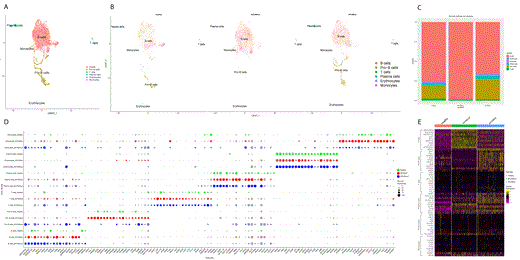Abstract
Waldenström macroglobulinemia (WM) is a low-grade B- cell lymphoproliferative disorder characterized by bone marrow (BM) infiltration by small lymphoplasmacytic lymphoma (LPL) cells that secrete monoclonal IgM immunoglobulin. Our understanding of the pathogenesis of WM has improved significantly by the discovery that the vast majority of patients with WM harbor the somatic mutation L265P in MYD88 gene on their clonal cells. However, the small fraction of patients (3-10%) that lack mutations in MYD88 is characterized by a different clinical course, with an increased risk of disease transformation and probably shorter overall survival. WM is a clonal disease but there may be significant heterogeneity within the clone, which may be associated with clinical outcomes, however, this has not been extensively explored. Recent advances in the area of single-cell RNA sequencing (scRNA-Seq) technologies have improved so that it is feasible to sequence and analyze thousands of cells per tumor delivering significant insights into a tumor's cellular heterogeneity and the biological features that distinguish different cell populations.
To better understand the differences occurring in the B cell composition between WM patients harboring the MYD88 L265Pmutation and those with MYD88 WT respectively, we performed single-cell RNA sequencing on CD19+ sorted cells from BM aspirates of these patients. Both patients were wild type to CXCR4 mutations. Overall, we characterized 8,517 cells from one MYD88 L265P WM patient (3,116 cells), one MYD88 WT patient (3,348 cells) and one healthy donor as control (2,053 cells). Clustering of these cells based on their gene expression profile, revealed that the majority of the cells form a large cluster corresponding to B cells (naïve, immature and mature;6852 cells) while the rest of the cells were classified into four broad cell types ranging from pro-B cells (1243 cells) to only few cells belonging to mature populations engaged in the immune response such as plasma cells (190 cells), T cells (124 cells) and monocytes (53 cells) indicating a high purity of the samples (≥95%) (Fig 1A). Clonality assessment showed high lambda light chain expressing populations in both patients and as expected an evenly distributed polyclonal population in the healthy donor.
To investigate the relative composition of the different cell types between the two genetically distinct WM patients (MYD88 L265P vs MYD88 WT) we searched for populations that were enriched in the B cell repertoire compared to the normal BM. From our data we observe a significant enrichment of pro-B cells in the MYD88 WT patient which is almost completely missing in the MYD88 L265P patient and an enhanced naïve B cell population in MYD88 L265P patient compared to both MYD88 WT patient and the healthy donor (Fig 1B, C). In addition, immature B cells are 3-fold higher in WM patients compared to the healthy donor. Differential gene expression analysis in B cells showed that among both patients several genes are highly expressed (>1.5 log2 fold-change) compared to the healthy donor such as CD52, FCMR, CD74, CD37 and HLA-DPA1. Genes that were highly upregulated in the MYD88 mutant compared to the wild-type WM patient include CXCR4, TXNIP, ID3, LLT1, MTRNR2L8, ZFP36L2 and ZNF331. On the other hand, genes that are highly upregulated in the wild-type phenotype compared to the mutant phenotype include MS4A1, CD79A, CD82, CD1C, KIAA0040, CD72, EGR1, SYK, and LGALS1 (Fig 1D, E). Distinct pathways enriched by genes differentially expressed by the MYD88 mutant B cell population include response to corticosteroid and hypoxia whereas in the MYD88 wild type patient unique processes include B cell activation and receptor signaling pathways, immune response and NFκB signaling.
In summary, our results show that there is a distinctive transcriptional profile in the B cells from the MYD88 WT patient where most differentially expressed genes do not overlap with the gene expression of the B cells from the MYD88 L265P patient, which may provide further mechanistic insights into the differences in biology and clinical presentation in patients with MYD88 WT versus those harboring MYD88 L265P. Further evaluation in additional patient samples is ongoing to gain additional insights in pathways that may be involved in disease transformation and response to therapy with targeted therapies, either targeting CD20 or BCR pathway.
Gavriatopoulou: Genesis: Honoraria; Sanofi: Honoraria; Karyopharm: Honoraria; Takeda: Honoraria; GSK: Honoraria; Janssen: Honoraria; Amgen: Honoraria. Terpos: Genesis: Consultancy, Honoraria, Research Funding; GSK: Honoraria, Research Funding; Janssen-Cilag: Consultancy, Honoraria, Research Funding; Novartis: Honoraria; Takeda: Consultancy, Honoraria, Research Funding; Sanofi: Consultancy, Honoraria, Research Funding; Celgene: Consultancy, Honoraria, Research Funding; BMS: Honoraria; Amgen: Consultancy, Honoraria, Research Funding. Dimopoulos: BMS: Honoraria; Takeda: Honoraria; Beigene: Honoraria; Janssen: Honoraria; Amgen: Honoraria. Kastritis: Amgen: Consultancy, Honoraria, Research Funding; Genesis Pharma: Honoraria; Takeda: Honoraria; Janssen: Consultancy, Honoraria, Research Funding; Pfizer: Consultancy, Honoraria, Research Funding.


